The AMD Trinity Review (A10-4600M): A New Hope
by Jarred Walton on May 15, 2012 12:00 AM ESTAMD Trinity Gaming Performance
After the 3DMark results, you might be wondering if Intel has finally caught up to AMD in terms of integrated graphics performance. The answer is…yes and no. Depending on the game, there are times where a fast Ivy Bridge CPU with HD 4000 will actually beat out Trinity; there are also times where Intel’s IGP really struggles to keep pace. The good news is that at least everyone is now onboard the DX11 bandwagon, and compatibility with games has improved yet again for Intel. Here are our “Value” benchmark results for seven recent games; we’ll have more information in a moment.

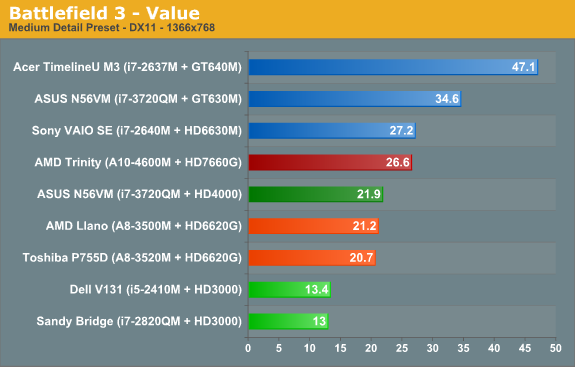
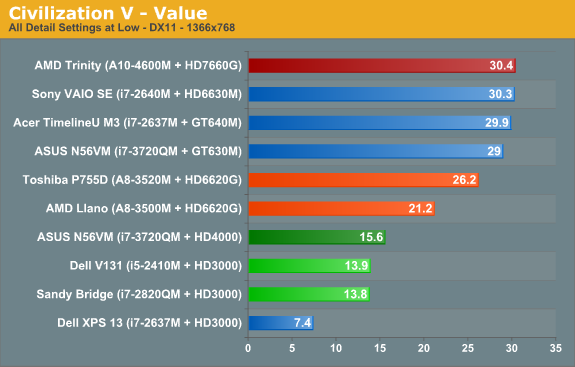

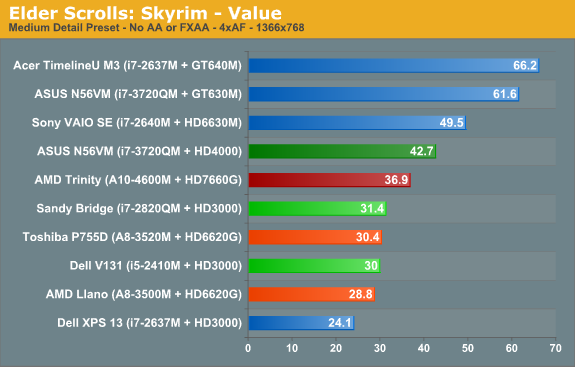
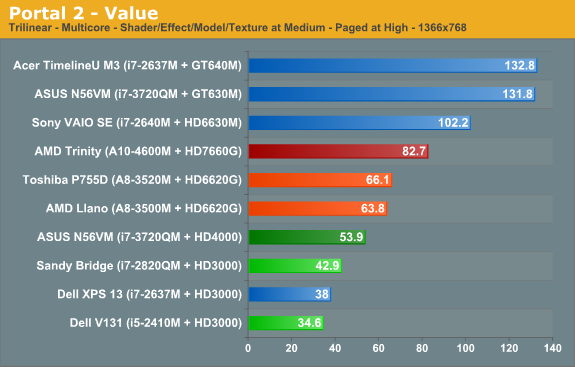
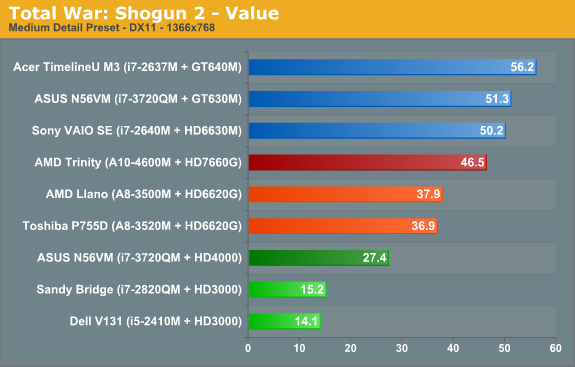
Out of our seven test titles, AMD’s Trinity leads any other IGP in four titles by a large margin. The other three titles actually have Ivy Bridge slightly ahead of Trinity, but the gaps aren’t nearly as big. Overall, the average performance across the seven games at our Value (medium) settings has AMD’s Trinity A10-4600M leading Intel’s i7-3720QM by 21%, and if we look at quad-core Sandy Bridge with HD 3000 (i7-2820QM) Trinity is 72% faster. Trinity is also around 20% faster than 35W Llano on average.
Let’s expand our gaming suite just a bit to see if things change, though. Just like we did with Ivy Bridge, we ran the eight games in our previous benchmark suite at medium detail settings. We can then compare performance across a wider 15 title selection to see how Trinity matches up against HD 4000, HD 3000, and HD 6620G (Llano). We’ll start with the bottom (HD 3000/Sandy Bridge) and move up.
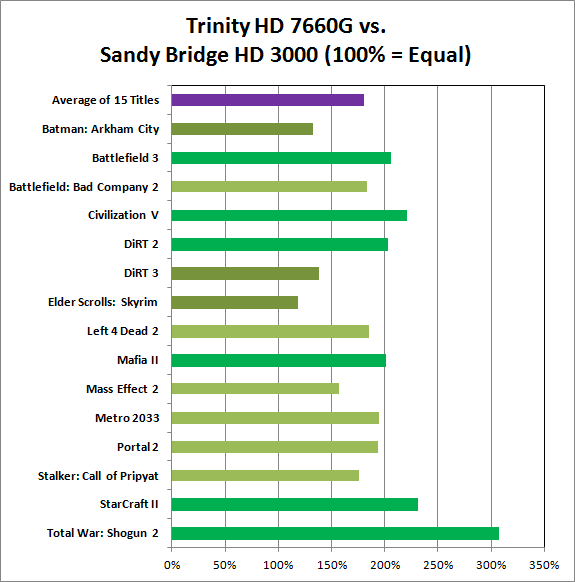
Llano’s HD 6620G was already faster than HD 3000, and Trinity’s HD 7660G is faster than Llano, so the Sandy Bridge gaming matchup is a landslide victory in AMD’s favor. The closest Intel can get is in the same three titles where Ivy Bridge leads Trinity: Batman: Arkham City, DiRT 3, and Skyrim. Here, however, HD 3000 can’t actually close the gap and HD 6620G is at least 20% faster than HD 3000, with an average performance improvement of nearly 80%.
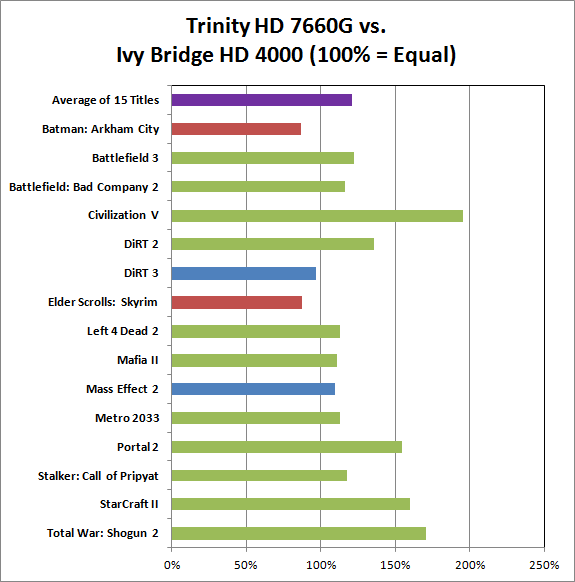
We found that across the same selection of 15 titles, Ivy Bridge and Llano actually ended up “tied”—Intel led in some games, AMD in others, but on average the two IGPs offered similar performance. This chart and the next chart will thus show a similar average increase in performance for Trinity, but the details in specific games are going to be different. Starting with Ivy Bridge and HD 4000, as with our earlier game charts we see there are some titles where Intel leads (Batman and Skyrim), a couple ties (DiRT 3 and Mass Effect 2), and the remainder of the games are faster on Trinity. Mafia II is close to our <10% “tie” range but comes in just above that mark, as do Left 4 Dead 2 and Metro 2033. The biggest gap is Civilization V, where Intel’s various IGPs have never managed good performance; Trinity is nearly twice as fast as Ivy Bridge in that title. Overall, it's a 20% lead for Trinity vs. quad-core Ivy Bridge.
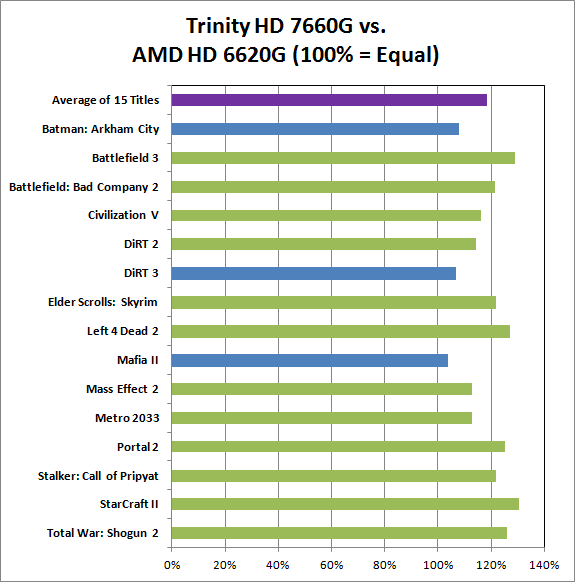
Against Llano, Trinity is universally faster, but the smallest gap is in Mafia II (3%) while the largest gap is in StarCraft II (30%). On average, looking at these games Trinity is only 18% faster than Llano. What’s not entirely clear from the above chart is whether we’re hitting CPU limitations, memory bandwidth limitations (remember that Llano and Trinity share bandwidth with the rest of the system), or perhaps both. At our chosen settings, what is clear is that Trinity’s “up to 56% faster” graphics never make it that high.
We saw 35-45% higher scores in 3DMark 11 and Vantage, which tend to remove the CPU from the equation more than actual games, so our guess would be that if AMD continues with their APU plan they’re going to need to work more on the CPU side of the equation. We also see the same thing looking at the VAIO SE scores in the earlier gaming charts: the HD 6630M scores are 20% faster on average, but much of that appears to come from the faster CPU rather than the GPU.










271 Comments
View All Comments
CeriseCogburn - Thursday, May 24, 2012 - link
The average home user needs adobe reader guy. They won't get by without it - the home user always has some adobe pdf they have to be able to open. So that's the whole base.You have failed.
Spunjji - Wednesday, May 16, 2012 - link
You have quite massively misinterpreted the type of person I am. I would not have a laptop running an SB i7 if all I wanted was "good enough" and I hate management who ignore the genuine requirements of their users.The point I am making is that Trinity does *not* perform like a 6 year old CPU. It is about 2 years behind Intel, granted, but most users I have encountered are 2 years back from that in their requirements. There are edge cases and you appear to be one. Good for you. I do not wish for this to be a pissing match, I do not know 100 million business users, I have just spent a long time mediating between ordinary people and I.T. and I do it for a living.
I will be recommending Trinity to people looking for a new laptop that is good for multi-use roles, won't break the bank, and oh yes is *new*. 6 year old processors are irrelevant when you're buying a new machine, in case you hadn't noticed, and people don't just replace laptops because they want something *faster*. Your inability or unwillingness to realise this puts you at a significant distance from the majority of buyers.
CeriseCogburn - Thursday, May 24, 2012 - link
No, core 2 duos are all over the place still brand new, so maybe your customers are getting really screwed.yyrkoon - Tuesday, May 15, 2012 - link
"It's like buying a laptop from 2004, with a DX11 upgrade."Not even close. I actually own a Liano system. An A6-3400m system that in reality only operates at 1400Mhz. Despite the marketing hype that it has turbo boost to 2300Mhz. Once the CPU heats up a little, 1400Mhz is all you get. The lack of responsiveness you mention is all in your head.
Besides, when / if there were application loading slow downs, I would have to question the application its self, the storage medium which I am using, or the fact that my own system is currently only running single channel memory - First.
Even if there were some noticeable performance hit. It is not as if I had A. D. D, and could not stand to sit another 5-10 seconds.
Key word. "Priorities". We all have them. College tuition vs a laptop that will play ( next latest greatest game ) *really fast*. You have your priorities. You make the call. For your own self.
potatochobit - Tuesday, May 15, 2012 - link
you are doing it wrong.if you need more than 1500mhz you need to turn on AMD overdrive.
it is not a problem with the computer, it means your bios is probably locked by the manufacturer. you might also try googling about k10stats.
yyrkoon - Tuesday, May 15, 2012 - link
Never said anything about needing more than 1400Mhz,. I said the responsiveness "issue" was all in the original posters mind. The point I was eluding to was that the A10 should be perfectly fine with a clock speed of 2300Mhz. Even better if it can be clocked higher while remaining in a decent temperature range. Which I am thinking it should.And yeah, K10STATs works just fine, for running the clock up to 2300Mhz. *If* I did not care about the laptop CPU temps running at 89C, and above. Which I would add, is the wrong way.
@rarson
I can retype it just for you, if my point was not clear. Sorry, the A6-3400M part must have thrown you. EL EL A EN OH - Better ? Or still too confusing for you ?
Seriously? Is that the best you've got ?
Roland00Address - Tuesday, May 15, 2012 - link
but can we have a follow up with how mobile trinity and ivy bridge handle diablo 3 since many laptop purchasers will be purchasing laptops with the express purpose of playing that game.A5 - Tuesday, May 15, 2012 - link
I can't imagine it'll be too different from Starcraft 2.dwade123 - Tuesday, May 15, 2012 - link
Meh. Just grab an Intel and at least a GT 640m. That's what most people would do.kshong - Tuesday, May 15, 2012 - link
The major problem that I will have with trinity is price. If Jarred's price estimate is correct (600-700 dollars), I think I will have to buy an ivy bridge cpu + nvidia geforce gt 640 computer.I wish AMD would sell an A-10 powered laptop for 450-550 dollars. Now that is a price that I am willing to pay for. Otherwise, I think I will pay a bit more to get something else.